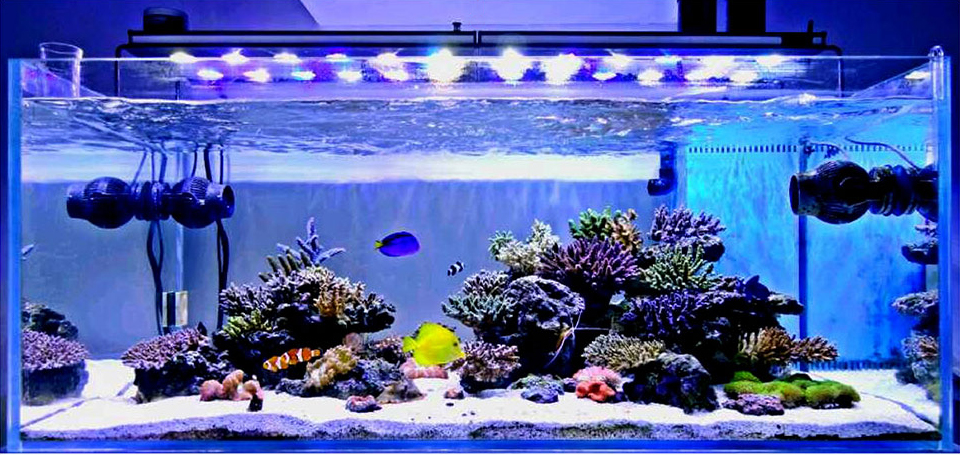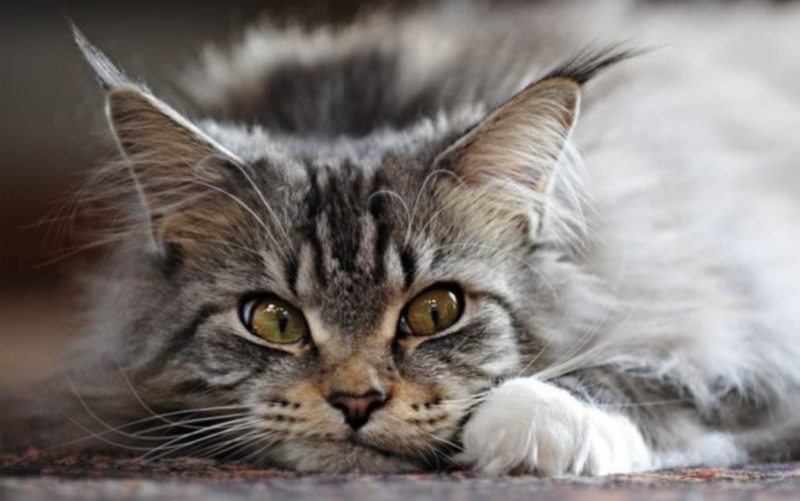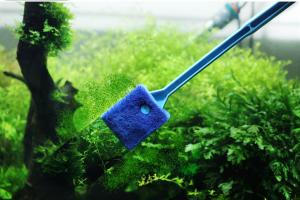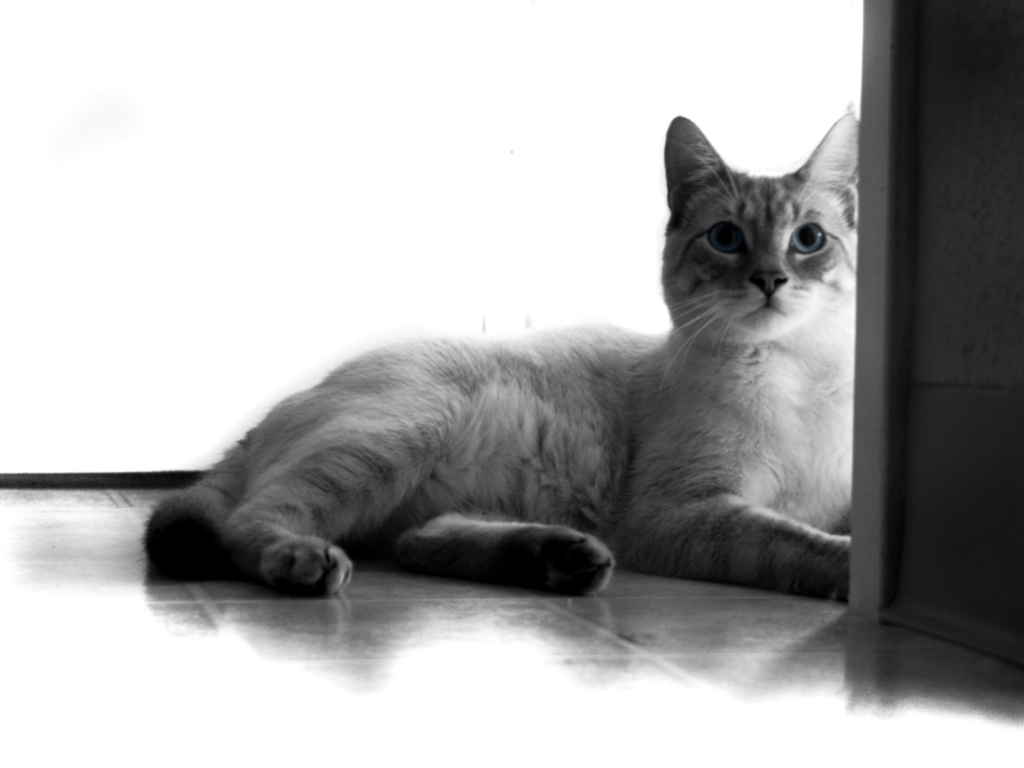... The smartest cat, and suddenly it! ...
... The kitten used to always go to the place, but here! ...
... It's definitely revenge! ...
What to do if the cat stopped going to the tray?
First of all, you need to pull yourself together and face the truth: a cat is not a person and it’s pointless to look for human motives in her actions. The reason that the cat suddenly stopped using the tray is most likely specific and not connected with the moral qualities of the cat. Therefore, it is useless to appeal to cat's prudence, and to poke a muzzle in a pile or a puddle, and even more so to slap a slipper and shout, is cruel and harmful.
What reasons can there be for unscrupulous cat behavior and how can the situation be corrected?
One of the most common reasons that an adult cat, or a cat, unexpectedly chose not their usual tray as a place of “think about the eternal”, but a nook, an old rug, or even a soft and warm master's bed - this is pain. Numerous diseases can cause the so-called "pain syndrome", which leads to a change in the behavior of animals. Its mechanism is as follows: a cat, writing in a tray, feels pain and connects it to the tray. Subsequently, this kitty will look for another place to urinate, sometimes choosing something soft and comfortable, where she feels completely safe.
Therefore, the first actions of any responsible owner should be aimed at eliminating a possible disease: consult a veterinarian, do the necessary tests and examinations (as a rule, if the cat is not peeing correctly, doctors at the Zoovet veterinary center recommend taking urine tests, possibly blood tests, and to exclude the inflammatory process of the organs of the genitourinary system).
If the cat’s health does not cause concern, the next thing to exclude is sex marks. If a young animal reaches adulthood (1-1, 5 years or earlier) and at the same time begins to tag, then castration will become the main method of correcting behavior. Distinctive features of marking the territory: cats mark with a "stream", while furniture, vertical surfaces, and household items suffer. Cats mark with a small amount of urine in different places, sometimes also with a stream (as a rule, marking the territory of cats coincides with the period of "sexual hunting").
The third possible reason for ignoring the tray can be severe stress associated with the appearance of a new family member (person or animal), moving, repairing, buying new furniture or scaring the cat at the very moment when she decided to use her tray. Such stress may well be excessive for the cat and often leads to the fact that the cat begins to choose a more secluded and protected place for excrement than the previous place in the tray. In this case, it is necessary to stop or minimize the effect of the frightening cat as soon as possible and create conditions so that it can use the tray without fear (it is very advisable to use light soothing agents: Feliway (diffuser) or drops based on herbs: Fiteks or "Cat Baiyun "). It will be best to place in each room where there were “cat surprises” a tray with a familiar and pleasant cat filler, and when she starts using them regularly, she will need to slowly begin to clean them, but not faster than once a day.
If the objective reasons for such an unpleasant change in the behavior of the cat cannot be identified, then perhaps the hostility causes the size of the tray (too large or small according to the cat), filler (you need to try using several types of fillers to choose the one that cat likes. Typically , cats choose a smaller and more loose filler, like Catsan, which you can dig into beforehand). Also, the cat may not like the place where the tray is located (noisy, located on the aisle, open, unprotected place).
The following must be taken:
Put several trays of different sizes and with different heights of the sides in the cat’s favorite places, if the cat continues to ignore the trays - change the filler and choose the one that the cat prefers. Carefully monitor the cat during this period - if you notice that she began to scrape the floor, meow suspiciously, fuss in one place - you need to immediately put her carefully on the tray, affectionately pronouncing how wonderful she is.
In no case should we forget that it is the smell that signals the cat where her toilet is! Any of the above methods to correct the problematic behavior of the cat must be supported by the complete elimination of the smell of cat urine and excrement in undesirable places. For this, it is necessary to carefully wash off the places where the cat urinated or defecated with a chlorine-free product (chlorine will only increase the smell of urine). You can use laundry detergents marked “bio” and special means to get rid of the smell of cat urine, which are now available in sufficient quantities. To consolidate the result, it is better to treat these places with a strongly smelling agent that is unpleasant for the cat: ointment "Zvezdochka", a special deterrent, or spread lemon or orange peels.
The ideal option is to make the place that you do not want to give the cat to the toilet inaccessible and / or unpleasant for her. To do this, narrow manholes and passages can be barricaded with plastic bottles and cardboard boxes (they can also be treated with a frightening spray on top) so that the cat could not crawl into it. If the cat preferred the bed to the tray, then cover it with polyethylene, onto which double-sided tape should be glued on top. The cat, jumping onto the bed, will stick, get upset, and understand that this place is not so pleasant and cozy, and in general, the tray is much more convenient for the toilet! It will be possible to remove the bottles, boxes and polyethylene in about 2 months, when the cat completely forgets that she once dreamed of a cozy corner under the bed.
And most importantly, remember that the cat, of course, will not be able to resist human patience, generosity and perseverance, and the joy of aiming at the tray will reward all the effort!
Consultations and appointments
How will the owner react if the cat has stopped walking in the tray? For one person, this will result in discomfort, the other will prefer to get rid of the four-legged. Unfortunately, the second option is more popular. Sooner or later, any owner gets tired of the endless washing of corners, washing furniture and the smell in the home. However, taking a warm lump into the house, you undertook to be near and grief and in illness, and such a cat’s behavior just falls under one of these options.
A sharp change in behavior is always explainable, although the reasons may not be obvious. The kitten that was accustomed to the tray, will not dirty the house just like that such oddities are not characteristic of a clean and picky tailed. Moreover, the advice of professionals and the most powerful tools will not help you if you do not find out the causes of incorrect behavior.
Naturally, we can’t list all the possible risk factors, however, they all come down to one global concept - Our pets are emotional, although this may not be noticed, they are jealous, worried, afraid, feel something was wrong and are worried about quarrels in the family. A new pet is also a delicate situation., the older cat knows that it is impossible to offend the baby, but at the same time sees a competitor in him.
Feline psychologists tend to reduce the uncleanliness of tetrapods to the following series of psychological reasons:
- At the first place, stress: moving, repair, sudden change in smell, loud noise, resentment, worries after visiting a veterinarian. The appearance of a child, not only in your family, but also in the neighbor’s (screaming, crashing strollers on the playground, etc.), can cause serious tailed experiences.
- Inappropriate place for tray or improper filler.
- Dirty or too clean tray - Some cats like their toilet to be washed daily. Other tailed ones perceive washing the tray as barbarism - you wash off the smell.
- Competition with other animals, not necessarily cats.

Tip: analyze all the changes that have occurred in your family over the past 2-3 months. At first, the ward can cope with stress and not give reasons for worries.
Instincts
Our pets belong to the class of domesticated animals, but this does not mean that instincts are alien to them. One of the unconditional habits is desire for security. The four-legged strive for comfort and peace, and this condition is achievable only when the whole dwelling has its “own” smell.
The cat marks the territory with special secretsthat are secreted by glands between the fingers and in the area of \u200b\u200bthe lip folds. During sexual hunting, the animal seeks to strengthen the fragrance and urine is mixed with secretion, from the glands that are under the tail. The cat lifts its tail and sprinkles a secret into every corner, especially the area near the front door is generously flavored. The cat’s behavior is less predictable, in fact, the pet craps everywhere and does not understand why it is scolded.
Read also: Do cats freeze in winter?
So, the conclusion is quite simple - if your cat did not go past the tray in childhood, but suddenly began to skod small - the matter is puberty. There are several ways to deal with this problem:
- Cover up all corners and hope that the problem is solved by itself. However, practice shows that in the case of sexual hunting, detergents and smart sprays are powerless. By removing the smell, you only provoke the pet to great efforts.
- Hold down your sexual instincts with hormonal drugs (injections, tablets). The effect of drugs is aimed at artificial alignment of the hormonal background of the animal. All would be well if it were not for the potential harm to the health of the ward. Unsterilized animals, and without external influences, are at a special risk group for the development of oncology, and hormonal drugs only increase this risk.
- - a method that will fix the situation with tags once and for all. An adult or already giving birth cat will experience hormonal fluctuations for another 1-6 months after surgery, and after that, the sexual instinct will weaken and the animal will not need to attract sexual partners. However, sterilization cannot be applied to absolutely all animals. The main, good reasons are tribal value (it’s up to the breeder to decide which priorities are more important), or an acute reaction to anesthesia. Not every old cat will undergo surgery; the recommended age is from 7 months to 8 years.
Important! Do not punish the cat for marking the territory. You will not scold the pet for breathing or wanting to eat? These instincts are too strong and cannot be influenced from outside!
Physiological causes of "bad" behavior
Suppose your cat walked steadily into the tray for several years and suddenly one of the following troubles occurred:
- The pet decided that the tray is no longer suitable for affairs for the most part, while puddles in the house does not appear.
- Cat start write near with a tray and "bury" their affairs, an imaginary filler.
- Tailed robber defiantly jumps on furniture and makes a puddle, right before your eyes, it doesn’t “stomp” before it and doesn’t bury it after.
If the trouble is repeated 2 or more times, the first thing you should do is show the animal to the vet! Problems with the tray can be explained by a very wide range of ailments. Here are just a few of them:
- - It can develop after sterilization (in the form of complications), spinal injuries, with chronic or inflammatory pathologies of the kidneys. Incontinence is easy to detect because the cat leaves wet footprints where it sits or sleeps.
- - age-related or pathological phenomenon, accompanied by atrophy of the bladder. In fact, the bladder turns into a bag with soft walls, which is filled to capacity, and urine comes out only under natural pressure.
- - the cat wants to urinate, but can not. At the same time, the animal is in pain. When the bladder overflows, the pet literally squeezes urine from itself, sometimes with an admixture of blood.
- - Symptoms similar to cystitis: the cat is hurt, she wants to go to the toilet, but cannot go. The reason lies in the stones (sand), which clogged the ureters or caused inflammation of the kidneys.
Read also: Collars for cats: what they are

Tip: If in your city there are no large veterinary clinics in which you can examine your pet, do an elementary urine test. An increased protein index will confirm the inflammatory process of the genitourinary system.
For heaps left in the wrong places, behavioral causes are more likely. Pathologies in which the pet may not bring the treasure to the tray are:
- Diarrhea - everyone knows that "pinched mental feeling" when the body refuses to obey. Motivation coaches even have a catch phrase: "When a person wants to use the toilet, he does not look for reasons to postpone it until tomorrow." Cats (in this regard) are no different from us. If the pet is overtaken by diarrhea, then the disaster along the way to the tray is quite predictable.
- Strong gagging in combination with diarrhea, can lead to partial bowel movements.
- - leads to severe itching and constant urge to go big. A cat can ride on a causal place on carpets, leaving “traces” or do other, unexpected incidents. The problem is solved by cleaning the glands when visiting a veterinarian.
- - similar to the previous paragraph, but in a more advanced form. Trying to scratch the sore spot, the cat infects the already irritated tissues of the anus. To itching and constant urge, monotonous pain is added. When a four-legged man tries to relieve himself, the pain becomes acute. As a result, the cat develops the habit of avoiding the tray (it hurts there) and enduring to the last.
Note! Cats with claws removed cannot walk into the litter box! It hurts them to step on the sand and even more so dig it.
Re-accustoming to the tray
After examination by a veterinarian and obtaining an opinion, you must either treat the animal, or proceed to adjust the behavior. If the pet was ill with a serious pathology or was in pain, when trying to relieve his need, he could develop conditioned avoidance of the tray. This nuance is not a sentence, enough:
- Change tray model.
- Use special fillers (with flavorings).
- Be patient and train the cat again to the tray, by analogy with the training of a kitten.
A cat’s relationship with its tray can rarely be called simple. Usually the owners need to make a lot of effort in order to point the kitten to a suitable place for sending needs. It also happens that an animal, already accustomed to its toilet, suddenly refuses it and chooses a new place for emptying the bladder. The owners of pets see the reason for such a change in moods in their capriciousness, effeminacy, and other mortal sins, while a variety of prerequisites may be hidden behind such behavior. We will talk further about why the cat stopped going to the tray and how to help him find his way back.
Any educational measures should begin with a search for the causes of changed habits. Only by answering the question “Why?” We can move on to the question of methods of exposure. In order to determine the reasons, the owner needs to cope with irritation and annoyance and follow the cat in order to better understand its condition.

The physiological side of the issue
Before you understand the fragile mental organization of the cat and its deep hostility to the tray, it is necessary to discard the possible pathologies and structural features of the genitourinary system.
Cystitis
The cause of cystitis can be both sitting in a draft and the growth of pathogenic bacteria in the kidneys or in the urethra, which has a detrimental effect on the body. This disease is characterized by frequent urination and a constant feeling of thirst. However, its first manifestations may pass unnoticed by the owners of the animal.

With advanced forms of cystitis, the animal can hardly control the urge, which is why it starts to miss the tray. At the same time, the color of urine itself changes, becoming cloudy and dark, sometimes you can even see blood impurities in it. It is important to recognize this disease in time in order to prevent its transition to a chronic form.
Urolithiasis (ICD)
The development of the ICD is favored by a variety of factors:
- unbalanced nutrition;
- protein oversaturation;
- lack of vitamin (in particular - vitamins of group A);
- hormonal disruptions;
- digestive disorders;
- hereditary predisposition.

Symptoms of urolithiasis are largely similar to manifestations of cystitis. The pet often visits the tray, meows loudly in the process of emptying the bladder. The difference between the ICD is that trips to the toilet often turn out to be futile due to the fact that stones interfere with the excretion of urine from the body. In such a painful condition, the animal may simply not reach the tray and relieve itself in the wrong place. At the time of treatment, the owner will have to put up with this state of the cat and support it.
Hyperthyroidism
It is quite difficult to recognize hyperthyroidism, due to the fact that the symptoms of this disease cover several aspects of a pet’s life at once:
- A sharp increase in appetite, combined with weight loss;
- Cardiopalmus;
- Frequent urination, accompanied by constant thirst;
- General condition of overexcitation and hyperactivity;
- Digestive disorders.

Hyperthyroidism is characterized by an increase in the thyroid gland, and, as a result, the production of hormones in an excessive amount. This disease affects cats in whose feed there is a deficiency or an excess of iodine, which affects the synthesis of hormones. Diagnosis of hyperthyroidism in the early stages will help protect the cat from cardiovascular diseases and gastrointestinal tract pathologies, as well as solve the problem with the tray.
The psychological side of the issue
Cats perceive an apartment or house as their own territory. Any violation of boundaries or a change in the situation causes stress in pets and prompts to change behavioral stereotypes. If indifference to the tray is not combined with other painful manifestations, then it is probably the cat’s emotional experiences that the owners often ignore.

Table 1. The reasons for the psychological nature
| Premise | Description |
|---|---|
| The belief that animals are absolutely not squeamish and do not feel embarrassed during bowel movements is deeply erroneous. Many pets put up with placing the tray in an inappropriate public place, while other cats are depressed by this state of affairs and they have to look for alternative places. In order to make the trip to the pet tray as comfortable as possible, set it in a quiet place, far from the hustle and bustle |
| Unsterilized cats have their own vision of the house, which is rarely consistent with the owner. Urination for the cat is a means of setting boundaries and warning that this place belongs to him. In addition, using marked angles, cats attract females and transmit information about their readiness for mating. The only way to avoid this behavior is to castrate the cat. Keep in mind that there is a certain age at which castration is most effective (it is different for different breeds) |
| Ignoring the tray may be demonstrative. Reasons for jealousy can be the institution of a new pet, replenishment in the family, etc. As soon as the cat feels that the portion of attention he needs has been truncated, he can move on to radical measures in order to return the owner back. There are certain breeds that are particularly sensitive to lack of attention. These include Siamese cats, orientals and sphinxes. |
| The basis of the cat’s behavior is always laid by the relationship with the owner. It is in them that lies the cause of many inexplicable behavioral deviations of pets. Some cats just need a careless word thrown in their direction, or an abandoned slipper to harbor resentment. Through urination in the wrong places, pets symbolically take revenge |
| This reason is difficult to attribute to the physiological or psychological aspect, since it is dual in nature. In case of head injuries, even with the subsequent recovery of the pet, pets can perform atypical acts for them. Serious incidents such as a fall from a balcony or a tree sometimes lead to inhibition of mental functions while the pet is in general satisfactory condition. In such cases, the only way out is to take care of the pet and a complete refusal of punishment |
| If your house has several cats, then competition between them is inevitable. Attempts to establish hegemony for eating or for using any other resources take place in every feline pack, albeit consisting of two people. The situation is complicated if an adult cat begins to compete with a small kitten, unable to fend for itself. The way out of this situation is quite simple - you should buy each pet a tray and place them away from each other so as not to provoke a struggle for resources |
Claims to the tray
Sometimes the reason for the pet to avoid the tray lies on the surface itself. Cats are very demanding on the materials of both the tray itself and the filler. For example, the cheap plastic from which most trays are made repels our four-legged friends due to an unpleasant odor that a person does not even catch. Among the other reasons for the uncomplicated understanding between the toilet and the pet are the following:
- Unclean tray. The above sensitivity of cats to odors makes it difficult to reuse the tray without changing the filler. The most common reason a pet refuses a tray is its contaminated condition. The cleaner the tray, the higher the likelihood that it will begin to be used for its intended purpose;

- Incorrect tray shape. Making a mistake in choosing a tray is much easier than it may turn out. In addition to cheap plastic, there are many other pitfalls that are difficult to predict. Sometimes the owners buy too high trays, and then they are surprised that the kittens do not use them. In some cases, the leading role is played by the dimensions of the tray - the cat should be able to freely dig in its stool, if it is deprived of this “privilege”, then it starts looking for it in another place. Often cats ignore lattice toilets, since it prevents them from contact with the filler;

- Incorrect filler. The choice of filler is a difficult process, since there are no specific rules that a person could follow when buying. The reaction of each cat to a specific filler is individual. Some pets like the classic wood filler, some are happy to use silica gel. The only way to find the right filler is to go through trial and error. Sooner or later you will find a compromise with the cat. About and their utility can be read on our portal;

- Fragrances. Some fillers these days are supplied with fragrances that mask unpleasant odors. Despite the fact that the aromas of lavender, roses and spruce can be pleasant to the owner, they make a negative impression on pets. Remember that the closer the filler is in composition to natural materials, the more convenient it is for a cat to use it. Initially, wild cats used ordinary land to dig in excrement, and their home relatives inherited this habit. The simpler the material used, the better. It is also recommended to avoid strongly smelling detergents when processing the tray. Soapy water will be quite enough;

Why doesn’t the cat go to the tray?
A separate consideration requires the question of bowel movement by the pet and the obstacles that arise in its way. Cases in which cats retain feces in the body for a long time are quite common and can have a detrimental effect on animal health. It is important to pay attention to the complications that have arisen and take appropriate measures depending on the age of the pet.

Kittens
Accustoming kittens to the tray is a difficult period for both humans and animals. As a rule, accustoming coincides with separation from the mother, or even moving to a new home, which only complicates the process of getting used to. In addition to breaking up with the mother, the pet has other good reasons for not refusing the tray:
- An unfamiliar environment causes the kitten inevitable stress, which he does not cope with immediately. Many kittens hide for the first days from the owners in the apartment, settling in only on the fifth or sixth day. Do not rush them;

- A sharp transition from breast milk to any other feed is a small shock to the body and takes time to rebuild the digestive tract. It is especially difficult to get used to dry food, causing prolonged constipation;
- Too frequent or too rare feeding, coupled with the use of the wrong foods, can also disrupt the kitten's digestion and lead to digestive problems;

- In rare cases, congenital bowel obstruction occurs. This pathology poses a direct threat to the life of the pet and requires urgent surgical intervention.
Adult cats
In mature individuals, bowel movements are associated with a large number of possible complications. The most common among them are as follows:
Lumps of wool stuck in the esophagus
Since cats periodically lick, it is naive to think that all the "eaten" wool leaves the animal body unhindered. On the contrary, this fluff has the property of being compacted and blocking the intestines, making it difficult not only to get rid of feces, but also their formation. To help the cat digest the coat, it is advisable to add grass to its diet. About what other methods you can resort to to help the cat clean the esophagus of wool, we describe below.

Inactive lifestyle
The work of digestion largely depends on physical activity, and if your pet is bedridden, then you should not even dream about the coordinated work of the digestive tract. To balance the metabolism and normalize the process of digestion of food, it is necessary to pay attention to the pet and occupy it with games that require movements.

Sex Hunting Season
During sexual arousal in non-castrated animals there is a hormonal surge that radically changes their everyday habits. Cats can refuse food, and, as a result, from using the tray simply because they are moved by other goals and do not notice their “base” needs, looking for a partner. As already mentioned, the only way to avoid the urge to mate in cats is to castrate them in time.

Postpartum period
In the first days after the birth of kittens, the female experiences severe stress, especially if lambing occurs for the first time. This stress is associated with both physiological overload and the need to feed kittens. Cats prepare in advance for childbirth and strive to cleanse their intestines as much as possible, because the lack of stool in a recently nursed pet is normal. It is worth contacting the veterinarian if the cat continues to ignore the tray for a long time.

Castration Recovery
The operation is always a shock to the body of the pet. He is worried not only by protracting wounds in the inguinal region, but also by the effects of anesthesia, which disrupt coordination and inhibit the functioning of the nervous system. Therefore, there is nothing surprising in the fact that the cat departing from the operation will miss the tray or not reach it at all. At such moments, he barely keeps his balance and needs the help of the owner.

Moreover, sometimes the process of instillation itself can be dangerous for the animal due to the ingress of small particles of filler into dissected areas of the flesh. To avoid irritation of the wounds, the owners use diapers for cats to facilitate the restoration of the pet.
Trained to the tray
The sooner your pet realizes the benefits of the tray and accepts it, the easier it will be to continue its relationship with the toilet. It is advisable to start training from childhood to lay the correct behavioral attitudes in the kitten, which will become a habit for him and will not need to be adjusted. Such training should be free from violence or annoyance, based on the following recommendations:
- Put the kitten on the tray several times a day. At first, he will not understand his purpose; one should not expect quick results. But over time, the pet itself will show interest in this plastic item without your efforts;

- To make acquaintance with the tray effective, take the kitten to the toilet after eating. The digestive tract of kittens is faster, because the urge to empty them follows feeding;
- Learn how to determine the behavior of a kitten when it needs a tray. At such moments, the animal scratches the floor with its paws and sniffs the corners, looking for suitable territory. When you see similar “symptoms”, take the kitten to the place you need in advance;
- Refrain from irritation or anger. Kittens perfectly capture the emotional state of the owner, and if trips to the tray will be associated with negative experiences, the training will be delayed.

- Kittens are guided by the smell of urine, because it is on it that you need to focus on training. Blot the puddle left after the pet with a napkin and put it in the tray, so it will be easier for the kitten to find the toilet reserved for him.
When a decent cat or cat ceases to pay attention to the tray - this is a problem. I will consider the reasons that can lead to this trouble, why the cat stopped going to the toilet and what to do. I will recommend what methods exist to wean a pet, depending on what served as an impetus for him. I’ll tell you what types of reasons are there: medical and behavioral.
Medical reasons why the cat stopped walking in the tray
Hormones
The cat can ignore the existence of the tray due to the beginning of a riot of hormones. This is the first reason why cats, growing up, begin to crap past the tray, but not nearby.
The hormonal background becomes very high, and therefore the behavior of an adult pet changes.
He begins to not only mark corners everywhere and protruding pieces of furniture, but also leave puddles in different parts of the apartment. In truth, scolding him for this is not justified, since the cat does not understand that he is doing something bad. For him, these are natural, logical actions. Then it is better to castrate or sterilize the cat.
Instinct
This is slightly different from the rapidly changing hormonal background, although in physiological terms, it seems. Because of the desire to determine the boundaries of its territory, the cat begins to go piss and not just past the tray, but anywhere in the apartment.
Urological pathology
Diseases associated with damage to the urinary system are equally common in pets of different sexes.
With trauma to a section of the urinary canal, frequent and involuntary urination can occur.
The cat does not have time to run to the tray, even if he wants it very much and writes where it happened. A variant is possible when stones enter the urinary tract and then the process of urination causes great pain, and may even stop altogether.
In addition to problems with the urinary system, senile deterioration of thinking can develop: the cat does not understand that he is doing something wrong or is simply missing.
Bowel inflammation and colitis can also develop, affecting the nature and painful bowel movements.

Behavioral causes
For ideological reasons
When the owner buys a new clean tray, which is more expensive and more beautiful than the previous one, then he remains satisfied with himself. However, the pet may not consider this gift so good to use it. Something does not suit the pet, maybe even the tray identical to the previous one falls into disfavor. In this case, when the old tray is returned to the place, the pet will resume the correct steps to spoil the toilet. In addition, it is commonplace, but the toilet can be dirty, and it will shave in the corner, although this is not visible the first time.
Filler
Do not discount the habit of the animal to spoil it in a particular environment.
Moreover, this works both ways: if the cat spent all his life going to the wood filler, and then sand appeared - the cat has a shock or the owner has not changed anything and the filler remains the same, but the cat has the same shock. In this case, you can experiment with new fillers of synthetic or natural origin.
Smell
The idea of \u200b\u200bwashing a cat's toilet with scented soap or special odorous products only seems good.
In fact, the smell is a cat trap.
He does not understand why the beloved, a hundred times marked tray began to smell like unpleasant lavender, jasmine or the freshness of the sea?
 Clean your cat toilet as often as possible
Clean your cat toilet as often as possible Natural shyness
Yes, these arrogant creatures also have it. No one will like to defecate in the middle of a loud, noisy street.
If the tray has recently changed its location and has been moved by the owner from a secluded corner to the very middle of the apartment (according to the cat), this will be a stumbling block.
Revenge or stress
Often resentment makes you ignore the toilet and leave gifts throughout the apartment. What recently could hurt the feelings of a pet? FROM tress also plays an important role: moving, the appearance of a puppy, kitten, child or new family member. Was there recently something that could hurt the pet's psyche?
What to do and how to wean a cat to crap everywhere
Depending on the reasons, the tactics of dealing with the problem will be different. Behavioral changes make the owner take a closer look at his animal and understand what has changed recently: stress due to relocation, revenge for some unjust punishment or something else.
- The cat's toilet should be put in its usual place, replaced again with the old one.
- If there were attempts to change the filler, then return the old one. If not, then vice versa, try a new one.
- To wash with toilet soap, flavourless or not to use at all. Plastic also has its own smell, and your pet may not like it - pay attention when choosing a new tray.
- Weasel and love will smooth out the guilt in front of the offended pet. Stress is also treated with care, and you should not make changes to the filler or the location of the tray.
 There are owners who, not understanding the reason for the pet’s behavior, say that it’s stupid and can’t be trained
There are owners who, not understanding the reason for the pet’s behavior, say that it’s stupid and can’t be trained Medical reasons are decided by going to the vet. The doctor will calmly listen to the assumptions and offer his, in his opinion, the most probable ones. If hormonal imbalance - castration or herbal tinctures. The latter are given to the pet if radical measures are not desirable, and the owner plans to mate in the future. In the presence of diseases, pets are treated with drugs that eliminate pathology.
It may turn out that the guilt of the animal is minimal, and the owner himself contributed to such a deterioration in the behavior of his pet.
It is important to understand that often the owner himself becomes the reason that the cat stops walking in the tray and problems begin long before they become visible.
Therefore, systematic care and attention for the cat will prevent both behavioral and medical problems with the pet.
Are you the owner of a cute, mustachioed creature that has good behavior? But suddenly his exemplaryness disappeared somewhere, and the cat stopped walking in the tray. The owners begin to think about the reasons: many believe that the animal harbored a grudge and thus avenges, and someone suggests madness.
This behavior is a big problem. Some owners even abandon their pussies, as they can’t retrain the cat. These assumptions cannot be discounted, but often the problem lies elsewhere.
If the cat is not accustomed to the tray, but usually "craps" in the wrong places, then you need to identify these corners and stop the cat from doing its job. This is great. Several injections from the bottle destroy the odors of uric acid and prevent the cat from attempting to mark the territory again. At the same time, the spray is absolutely safe for health.

Why did the cat stop going to the tray?
The main causes of failure:
- Diseases If the true cause is a disease, then screaming and trying to teach him how to use a suitable toilet will not help again. Some of the possible reasons are:
- bodily harm - especially if the injury is in the abdominal cavity or the kidney is affected;
- cystitis - a disease of the bladder;
- stones in the kidneys;
- various inflammations.
If there are no visible manifestations of the disease, but the pet refuses to use the toilet, consult your veterinarian. He will prescribe the necessary tests and conduct an examination. Only in the case of a complete absence of disease, look for reasons in another;
- Cats are quite pedantic. Perhaps he is not happy with the cleanliness of his toilet. Many refuse to use the tray even with the slightest contamination. Wash the cat's toilet well and constantly check the cleanliness of the filler;
- The toilet is not suitable. Over time, you need to change the subject of a cat's toilet, but take your time to get rid of the old one. The new box that you liked so much in color and shape may not be suitable for the animal. Let the old thing be with you until the tailed one agrees to go to the new one;
- Not the right filler. If a pet has used the same filler all his life, and has recently refused, it may be the reason for it. Try switching to another;
- Smells. Do not buy flavored fillings. Of course it is much more pleasant when, instead of cat excrement, it is fragrant by the sea wave or forest, but the mustachioed may not like it. Limit yourself to neutral odors, it is better to clean the tray more often;
- A lot of extra eyes. Four-legged, like people, like to relieve themselves without too much viewing. Provide a secluded place;
- The psyche. Severe stress shock can cause the tray to drop. Animals are difficult to tolerate the change of familiar environment, the addition to the family, the appearance of new pets. In this case, shouting and punishment will not help to rectify the situation. It is necessary to create a calm environment, consult a doctor, perhaps you should give him sedatives;
- Jealousy. If an adult fluffy has a competitor in the form of a dog or another representative who sees in the dark, then the animal can attract attention to itself, by toilet trips in the wrong places;
- Anger. Animals, like humans, tend to be offended. So delve into the memory, perhaps you recently shouted at your ward, and he takes revenge;
- Sex drive. During this period, animals mark the territory.
Accustom a cat to any toilet, including a tray. If the cat stops going to the tray, you should not scold him. You just need to spray the tray with My Place spray. The cat will be attracted by the smell of the drug, which at the same time does not do any harm to his health. In a bottle of about 20 ml, one or two injections are enough every day.

The animal does not want to walk a little
If the cat has stopped going to the tray and is relieving herself, and you do not observe traces of urine, this is a cause for concern. This is a bladder disease. Domestic predators are prone to such diseases, cats that survive castration suffer the most from it.
The cat does not want to go big
If the kitten stopped going to the toilet in a big way - this indicates a disease. They can be called for several reasons:
- improper diet and diet;
- stressful situations;
- poor bowel function.
In any case, a doctor is needed. Ask what method will be needed: food with a laxative effect, an enema, or medication.

If the kitten has stopped walking in the tray
Your baby refused to make use of the toilet, maybe this is a disease. Go through a full examination with him, and then look for others.
If the kitten has stopped walking in the tray, you need to know what to do:
- choose the right size of the toilet, the animal needs enough space;
- for children, a tray with low walls is suitable, older ones can also with high ones;
- change the filler; maybe he just doesn't like it;
- stop using air fresheners and other chemicals for a while. Pungent odors can discourage going to the tray.
If the cat is tired of going to the tray, but the owner does not like that the code craps everywhere - there is a compromise solution. You can teach your pet to use the toilet. Its principle is that the cat with each week should go to the toilet with an even larger hole. The kit includes rings of different sizes of holes that are worn on the toilet.
Punish or not worth it?
Parenting is a difficult process, and you cannot do without punishment, but you must do it correctly. Limit the use of physical assault if the pet is a spoiler in the wrong place. You can not raise your voice. Punish only if the cat commits a crime before your eyes. In other cases, the animal will not understand why they are shouting at him, and harboring resentment, and the consequences will not be very pleasant.
Do not scold the animal if it marks the territory. This process is natural, and it is not realistic to control it.

Some more useful tips:
- the house has changed its usual environment, make sure that the changes do not create discomfort. Good attitude and tenderness will help you with this;
- in stressful situations, time will save you;
- choose a place in which the cat will be comfortable to relieve;
- if a cat at a respectable age change the tray with low sides;
- maintain cleanliness and clean the tray in time;
- mustachioed walks in the wrong place? Make it as repulsive as possible: overlay with foil, rustling paper, sprinkle balls. Well, as a last resort, make a place a piece of furniture;
- your pet has a habit of spoiling in the bathroom or sink, leave some water there. Fluffy just does not get there;
- if you are the owner of several animals, establish their relationship;
- if everything is normal, and he continues to walk past, use praise and punishment. When going to the wrong place, create unpleasant conditions: water from the spray bottle, create sharp, loud sounds. When I went to the toilet - praise the snacks and affection;
- keep an eye out. Perhaps if you will transplant the cat in the right place, then soon he will learn to walk in the right place;
- in any pet store you can buy special products that repel or attract you to go to a specific place. It is better to apply such products on a damp surface; the oils hold well in combination with water.
If you don’t know where to start, choose the simplest methods, possibly the reason. Surround the pet with love and affection, create comfortable conditions. And you will notice how your pet’s behavior changes.














